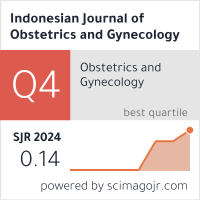Surgical Wound Dehiscence Treatment
Tata Laksana Dehisensi Luka Operasi
Abstract
Objective: This article describes management of surgical
wound dehiscence. in a cesarean section.
Method: Case report.
Case: A 39 years-old woman, P4, presented with reddish pus
coming out from open surgical wound on day 4 following a
caesarean section. Laboratory fi ndings revealed a condition
of Hypoalbuminemia, leukocytosis, and a Staphylococcus
aureus was detected on pus from the wound base. Upon the
resuturing, the wound was dressed with antimicrobial wound
dressings and pad and changed every 12 hours. After 3 days,
the wound was dressed with modern antimicrobial wound
dressings gel and pad, changed every 3 days and planned
for necrotomy afterwards. A presence of dry, granulation
tissue was observed before the resuturing.
Conclusion: Selection of dressing regimen should
be individualized according to the wounds. Modern
antimicrobial wound dressing can be a good therapy option
for surgical wound dehiscence after caesarean section.
Keywords: surgical site infection, surgical wound, wound
dehiscence.
Tujuan: Artikel ini melaporkan tata laksana dehisensi luka
operasi seksio sesarea.
Metode: Laporan kasus.
Kasus: Seorang perempuan 39 tahun, P4, datang dengan
keluhan nanah kemerahan keluar dari luka operasi terbuka
postoperasi seksio sesarea hari ke-4. Temuan laboratorium:
Hipoalbuminemia, leukositosis, dan Staphylococcus
aureus dari kultur dasar luka. Sebelum operasi penjahitan
kembali, luka dibalut dengan pembalut dan bantalan luka
antimikroba modern yang diresapi dengan hidrogel, diganti
setiap 12 jam. Setelah 3 hari, luka dibalut dengan gel dan
pembalut luka antimikroba modern yang diresapi dengan
hidrogel, diganti setiap 3 hari dan direncanakan untuk
nekrotomi. Sebelum operasi dilakukan kembali, luka tampak
kering dengan dasar jaringan granulasi.
Kesimpulan: Regimen pembalutan harus disesuaikan
dengan kebutuhan masing-masing luka. Pembalut luka
antimikroba modern dapat menjadi pilihan terapi yang baik
untuk dehisensi luka bedah setelah operasi seksio sesarea.
Kata kunci: dehisensi luka, infeksi luka operasi, luka operasi.
Downloads
Copyright (c) 2023 Indonesian Journal of Obstetrics and Gynecology

This work is licensed under a Creative Commons Attribution-NonCommercial-ShareAlike 4.0 International License.













